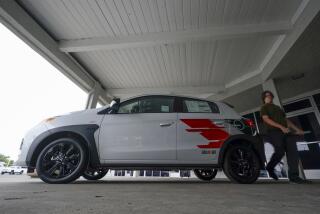Bumpy road ahead for industry?
Consumer prices are up. The stock market is down. The dollar has plummeted. And credit is tightening. So what does that mean for motorcycles -- not only future sales, but also new model development, pricing and financing? Well, it appears the bad news has some good mixed in.
On the up side, motorcycle sales in 2007 were over the 1-million mark for the fifth straight year. Battery and tire sales indicate that ridership and enthusiasm for the sport remain high. The down side is that sales in 2007 failed to increase after 14 consecutive years of gains and were lower than in 2006. By how much, the Motorcycle Industry Council won’t say until summer, when it has complete sales figures. But some manufacturers’ representatives have estimated an 8% to 10% decline. The U.S. Department of Commerce, however, puts the decrease at 2.2% for the year.
Particularly hard hit have been sales of small-displacement dirt bikes, which have seen larger-than-average losses, and Harley-Davidson, which has taken a 21% hit on its stock since the start of 2008, as of Tuesday’s close. (The latest Harley sales figures won’t be known until Friday, when the country’s largest motorcycle manufacturer issues its fourth-quarter earnings report, but its third-quarter motorcycle sales for 2007 were down 9% compared with 2006.)
Sales projections for 2008 range from flat to continued softening, but “nobody’s panicking,” said Jon Row, motorcycle press manager for American Honda Motor Co. “Nobody’s saying, ‘Get your gear bag and get in the lifeboat.’ The business is still very strong.”
In other words, manufacturers will continue to wheel out new models at the same pace we’ve become used to. They’ll just be doing it with increasing cost pressures.
The dollar has lost 26% of its value against the euro and 11% of its value against the yen since March 2003. Add escalating costs for the metals, plastics and other commodities used to manufacture motorcycles and the fuel needed to transport foreign models to the U.S. market, and you’ve got upward price pressures for the European and Japanese manufacturers in particular. That has makers looking to cut manufacturing costs rather than raise retail prices for consumers who, in the U.S., are continuing to tighten their belts.
Still, there’s already been some upward pricing from manufacturers. Ducati, for example, had to increase the price of its 1098 model by $1,000 shortly after introducing the bike last year because the company “couldn’t make money at the rate the dollar was sliding,” said Ducati’s John Paolo Canton.
Rising fuel costs are a double-edged sword for the industry because petroleum isn’t just used to make the gasoline that runs a motorcycle. It’s also used to manufacture the plastics in the bikes, to run the factories that make the bikes and to transport those bikes to the consumer, all of which cut into a manufacturer’s bottom line.
But rising gas prices do have an upside. While the percentage of people who use their motorcycles for commuting is minimal, higher gas prices mean some will ride their bikes more often, necessitating new parts and, more frequently, new bike purchases.
It’s also creating an emerging, more practical niche -- transportation -- in a market that’s mostly enthusiast-driven. Most of the 10 manufacturers I spoke with said the current economic downturn in the U.S. isn’t affecting their development of new models.
“We can’t make big changes to what we’re doing for 2009 because of continuing threats of recession or that kind of talk,” said Suzuki communications manager Glenn Hansen.
However, “we’re in an environment now where [fuel prices] have to be a priority for every manufacturer,” said Bob Starr, Yamaha’s corporate communications manager.
That may mean more fuel-efficient, transportation-oriented models in the coming years -- and more female- and youth-oriented models, since women and entry-level buyers are more likely to buy a bike for practical purposes.
The average cost of a gallon of gasoline has more than doubled in the last seven years, from $1.41 in January 2001 to $3.07 as of last week. So far, dual-purpose motorcycles and scooters have benefited most from higher fuel prices due to their comparatively high mileage ratings -- 50-plus mpg. Dual-purpose sales last year were the highest they’ve been since 1989, and scooter sales saw no decline.
Vespa saw an 18% increase in sales -- evidence that it isn’t just scooters but the high end of the market that’s doing well. Other boutique brands that beat the market: Ducati saw a 22% increase, and Victory and KTM were both up about 10%.
The low-end, i.e. Chinese product, also seems to be doing well. It’s the manufacturers that cater to the middle that, like the rest of the economy, seem to be hurting, though it isn’t clear by how much. Representatives for Yamaha and Kawasaki both say their sales were down, but less than the industry average. Honda and Suzuki each admitted losses that paralleled the industry overall, with a couple bright spots: dual-purpose bikes did well for Honda, and scooters rose 5% for Suzuki.
In addition to fuel economy, scooters benefit because they are low-priced. However, credit continues to tighten, financing could become an issue for higher-priced models.
According to the Motorcycle Industry Council’s 2003 Motorcycle Owner Survey, the most recent available, 27% of buyers said they financed their bike in full or in part. That number could be higher now that home values are down and buyers aren’t cashing out equities to buy bikes.
According to Edward Yardeni, an economist at Yardeni Research in New York, “One of the large consumer durable items that would be hardest to finance in this environment would be motorcycles,” because they are “among the most discretionary of consumer durables.”
That concern is echoed in the industry.
“The forecasting that we hear from our retail finance people is that the subprime mortgage fallout is really going to turn between March and May, when payments increase for people with questionable types of mortgages,” said Suzuki’s Hansen. “Because of that, our retail finance will probably get more expensive for people.”
A possible tax rebate from the federal government could help offset that. Still, manufacturers are adopting a wait-and-see attitude.
“We’re all very concerned,” said Laurence Kuykendall, communications manager for BMW North America. “We’re all watching to see what happens.”
And while we’re watching, we may as well ride.
As Larry Little, publisher of Cycle World magazine, said: “Once you throw a leg over a bike, it’s something you don’t want to miss. In fact, when you have to put up with political debates and wonder what the economy’s going to do, it’s something you need more.”
More to Read
Sign up for Essential California
The most important California stories and recommendations in your inbox every morning.
You may occasionally receive promotional content from the Los Angeles Times.










